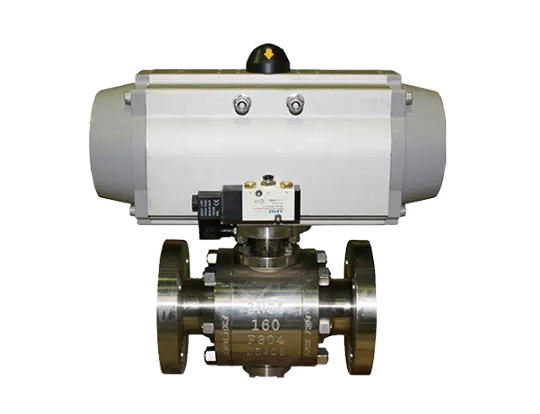- English
- Español
- Português
- русский
- Français
- 日本語
- Deutsch
- tiếng Việt
- Italiano
- Nederlands
- ภาษาไทย
- Polski
- 한국어
- Svenska
- magyar
- Malay
- বাংলা ভাষার
- Dansk
- Suomi
- हिन्दी
- Pilipino
- Türkçe
- Gaeilge
- العربية
- Indonesia
- Norsk
- تمل
- český
- ελληνικά
- український
- Javanese
- فارسی
- தமிழ்
- తెలుగు
- नेपाली
- Burmese
- български
- ລາວ
- Latine
- Қазақша
- Euskal
- Azərbaycan
- Slovenský jazyk
- Македонски
- Lietuvos
- Eesti Keel
- Română
- Slovenski
- मराठी
- Srpski језик
Are there any special considerations for installing a pneumatic forged ball valve?
2024-09-26

What are the advantages of using Pneumatic Forged Ball Valve?
Pneumatic Forged Ball Valve has various advantages over other valves, which makes it suitable for different applications. Some of the benefits include:
- They are reliable and durable.
- They have a high flow rate.
- They are easy to operate, control and maintain.
- They provide tight shutoff when closed, preventing any leakages.
- They can handle high pressure and temperature.
How is Pneumatic Forged Ball Valves installed?
The installation process for Pneumatic Forged Ball Valve is vital as it directly impacts the performance of the valve. Here are some steps to follow:
- Identify the suitable location for installing the valve.
- Prepare the installation surface to ensure it's level and clean.
- Ensure that the valve is compatible with the piping system and fits correctly.
- Use appropriate tools to fasten and secure the valve in place.
- Connect the valve to the pneumatic actuator and compressed air supply.
- Check for any leakage or damage to the valve.
What are the special considerations for installing Pneumatic Forged Ball Valve?
When installing Pneumatic Forged Ball Valve, there are specific considerations to keep in mind to ensure optimal performance. They include:
- Ensure the valve is installed in the correct orientation relative to the flow direction.
- Ensure there is sufficient clearance around the valve to facilitate maintenance and repair.
- Ensure that air supply for actuation is clean and dry.
- Ensure that the operating temperature range and pressure range of the valve are compatible with the application.
Conclusion
In conclusion, Pneumatic Forged Ball Valve is a versatile valve suitable for various applications, thanks to its reliability, durability, and tight shutoff. During installation, it's essential to follow the correct process to ensure optimal performance and prevent any damage to the valve. Keeping in mind the specific considerations for installation can help enhance the valve's performance and longevity.
Zhejiang Liangyi Valve Co. Ltd is a leading manufacturer of valves, including Pneumatic Forged Ball Valves. Our valves undergo rigorous testing to ensure compliance with international standards. Contact us at sales@gntvalve.com for high-quality valves that meet your specific needs.
References
1. M. A. Kashkooli and A. Mahdavi, 2018, 'Experimental and numerical investigation of a forged ball valve: a case study,' Journal of Mechanical Engineering Research and Developments, vol. 41, no. 4, pp. 678-684.
2. R. R. Cole and D. R. Brock, 2016, 'High-temperature, high-pressure ball valve performance considerations for production applications,' Offshore Technology Conference, Houston, Texas.
3. G. S. Arora and R. K. Thakur, 2015, 'Design, modeling and analysis of pneumatic valve actuator for pneumatic forging hammer,' International Journal of Innovative Research in Science Engineering and Technology, vol. 4, no. 12, pp. 11375-11381.
4. M. Z. Kouzani, S. Copley, M. K. Khosla and G. B. Lennox, 2014, 'Intelligent control of pneumatic artificial muscle actuated artificial finger,' Applied Bionics and Biomechanics, vol. 11, no. 1, pp. 27-38.
5. S. H. Lee and S. H. Park, 2019, 'Flow characteristics of valve opening and closing in the pneumatic conveying system using a ball valve,' Journal of Mechanical Science and Technology, vol. 33, no. 3, pp. 1433-1442.
6. H. Qiao, Y. Liu, Q. Xu, F. Zhang and M. Wang, 2018, 'Study on the structure optimization of pneumatic butterfly valve,' IEEE International Conference on Mechatronics and Automation, Changchun, China.
7. J. Yang, Y. Zhao and W. Zhu, 2017, 'The design of bionic pneumatic finger based on the ball valve,' Journal of Mechanical Science and Technology, vol. 31, no. 12, pp. 5731-5738.
8. P. Wang and S. Zhang, 2016, 'Modeling and design of a pneumatic control valve system,' 13th International Conference on Control, Automation, Robotics and Vision, Phuket, Thailand.
9. A. S. Nydahl and H. J. Jonassen, 2015, 'Experimental studies of pneumatic control valve systems with backlash compensation,' Control Engineering Practice, vol. 38, pp. 167-181.
10. C. Zhu, Y. Zhang, W. Wang and Y. Wang, 2014, 'Optimization of pneumatic air control valves based on artificial neural networks and genetic algorithm,' Advanced Materials Research, vol. 900, pp. 591-594.




